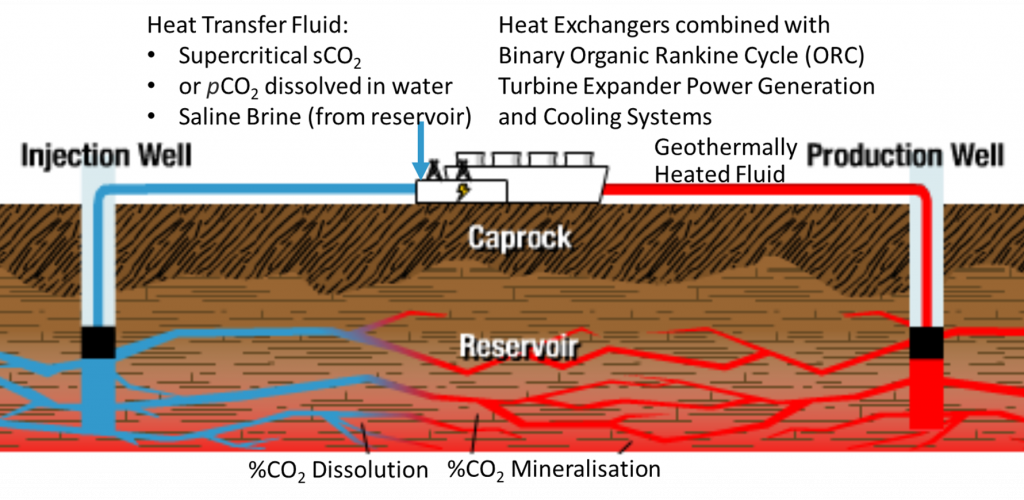
Carbon dioxide can be used as a component of geothermal heat transfer fluid for coupled Carbon Storage and Geothermal extraction in an Enhanced Geothermal System (EGS), which allows the technology to be economical at lower subsurface resource temperatures. The CO2 can either be supercritical CO2 (used at multiple locations for carbon storage) or pCO2 dissolved in water (e.g., CarbFix-Iceland’s carbon storage). Surface power generation equipment would use a resultant produced fluid being a mixture of reservoir fluid (e.g., saline brine), water, and some amount of CO2.
Using sCO2 , the difference in the density between the cooler injection well and the hotter production well provides some thermo siphoning that reduces the requirements for circulating pumps compared to water-based heat transfer fluid systems. sCO2 has 40% of the viscosity of water circulation so better reservoir flow potential to help offset the reduced mass heat capacity, so about the same net power production potential. •Partial pressure pCO2 dissolved in water and injected in mafic to ultramafic rocks at tens of bars to form magnesite, limiting the formation of Mg-rich clays, has good mineralisation of Ca and Fe carbonates at temperatures <150-170°C. Local pressure gradients, buoyant, viscous, and capillary forces must be considered during prediction of gaseous CO2 flow behavior in the subsurface formation.
In the process of CO2 circulation, some loss of CO2 would occur. The main reasons are permanent CO2 storage due to dissolution and mineral trapping mechanisms within the rock formations. The mineral dissolution and precipitation that form CO2 mineralization and storage in the reservoir could have a effect on the CO2-EGS heat extraction efficiency. Mineral precipitation may impair the reservoir’s fractures, potentially reducing reservoir permeability and heated CO2 production rates. Fortunately, the evaluation of these risks when considering injection pressures, temperatures, and potential rock lithologies is usually able to mitigate the risk.
Injection wells would be located away from production wells to help ensure adequate heat transfer time and reduce unplanned or preferential breakthrough of high rates of CO2.
Utilisation of the carbon dioxide storage potential of CO2-EGS can help compensate for the cost of the CO2 geological storage by producing electricity.
CO2-EGS is under development, and there is good support for CO2-EGS as a promising supplement to water-based heat transfer fluid-based EGS.

